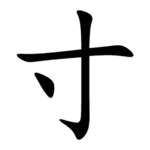Radical 41
| 寸 | ||
|---|---|---|
| ||
寸 (U+5BF8) "thumb, inch" | ||
Pinyin: | cùn | |
Bopomofo: | ㄘㄨㄣˋ | |
Wade–Giles: | ts'un4 | |
Cantonese Yale: | chyun | |
Jyutping: | cyun3 | |
Pe̍h-ōe-jī: | chhùn | |
Kana: | ソン son | |
Kanji: | 寸 sun | |
Hangul: | 마디 madi | |
Sino-Korean: | 촌 chon | |
| Stroke order animation | ||
 | ||
Radical 41 meaning "thumb" or "inch" is 1 of 31 Kangxi radicals (214 radicals total) composed of three strokes.
In the Kangxi Dictionary there are 40 characters (out of 49,030) to be found under this radical.
Characters with Radical 41

Great seal script character

Small seal script character
| strokes | character |
|---|---|
| without additional strokes | 寸 |
| 2 additional strokes | 对 |
| 3 additional strokes | 寺 寻 导 |
| 4 additional strokes | 寽 対 寿 |
| 5 additional strokes | 尀 |
| 6 additional strokes | 封 専 |
| 7 additional strokes | 尃 射 尅 将 |
| 8 additional strokes | 將 專 尉 |
| 9 additional strokes | 尊 尋 尌 |
| 11 additional strokes | 對 |
| 13 additional strokes | 導 |
Literature
Fazzioli, Edoardo. Chinese calligraphy : from pictograph to ideogram : the history of 214 essential Chinese/Japanese characters. calligraphy by Rebecca Hon Ko. New York, 1987: Abbeville Press. ISBN 0-89659-774-1..mw-parser-output cite.citationfont-style:inherit.mw-parser-output .citation qquotes:"""""""'""'".mw-parser-output .citation .cs1-lock-free abackground:url("//upload.wikimedia.org/wikipedia/commons/thumb/6/65/Lock-green.svg/9px-Lock-green.svg.png")no-repeat;background-position:right .1em center.mw-parser-output .citation .cs1-lock-limited a,.mw-parser-output .citation .cs1-lock-registration abackground:url("//upload.wikimedia.org/wikipedia/commons/thumb/d/d6/Lock-gray-alt-2.svg/9px-Lock-gray-alt-2.svg.png")no-repeat;background-position:right .1em center.mw-parser-output .citation .cs1-lock-subscription abackground:url("//upload.wikimedia.org/wikipedia/commons/thumb/a/aa/Lock-red-alt-2.svg/9px-Lock-red-alt-2.svg.png")no-repeat;background-position:right .1em center.mw-parser-output .cs1-subscription,.mw-parser-output .cs1-registrationcolor:#555.mw-parser-output .cs1-subscription span,.mw-parser-output .cs1-registration spanborder-bottom:1px dotted;cursor:help.mw-parser-output .cs1-ws-icon abackground:url("//upload.wikimedia.org/wikipedia/commons/thumb/4/4c/Wikisource-logo.svg/12px-Wikisource-logo.svg.png")no-repeat;background-position:right .1em center.mw-parser-output code.cs1-codecolor:inherit;background:inherit;border:inherit;padding:inherit.mw-parser-output .cs1-hidden-errordisplay:none;font-size:100%.mw-parser-output .cs1-visible-errorfont-size:100%.mw-parser-output .cs1-maintdisplay:none;color:#33aa33;margin-left:0.3em.mw-parser-output .cs1-subscription,.mw-parser-output .cs1-registration,.mw-parser-output .cs1-formatfont-size:95%.mw-parser-output .cs1-kern-left,.mw-parser-output .cs1-kern-wl-leftpadding-left:0.2em.mw-parser-output .cs1-kern-right,.mw-parser-output .cs1-kern-wl-rightpadding-right:0.2em
Lunde, Ken (Jan 5, 2009). "Appendix J: Japanese Character Sets" (PDF). CJKV Information Processing: Chinese, Japanese, Korean & Vietnamese Computing (Second ed.). Sebastopol, Calif.: O'Reilly Media. ISBN 978-0-596-51447-1.
External links
- Unihan Database - U+5BF8
| Wikimedia Commons has media related to Radical 041. |


